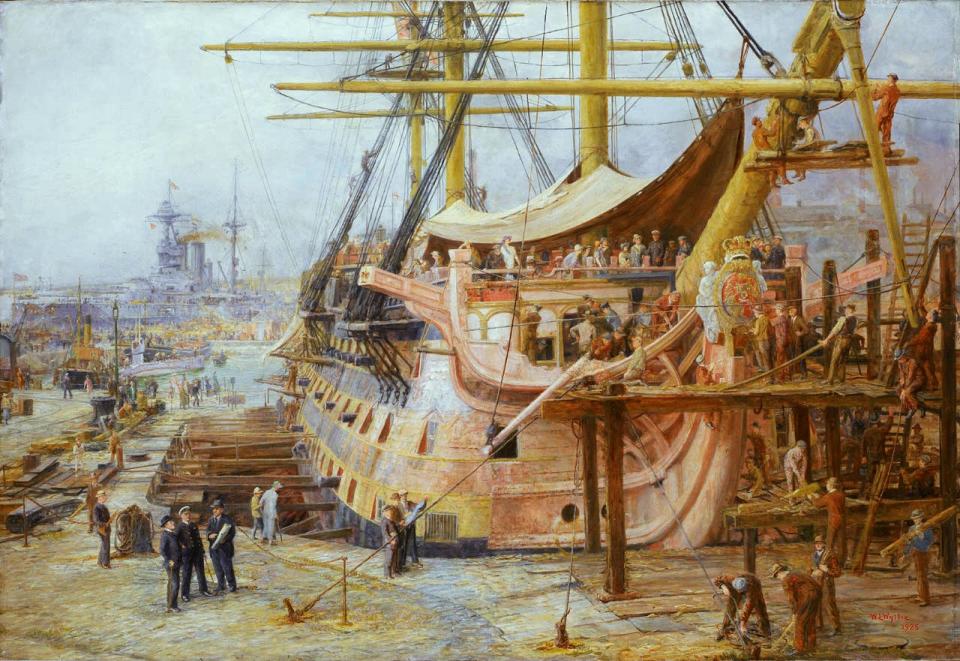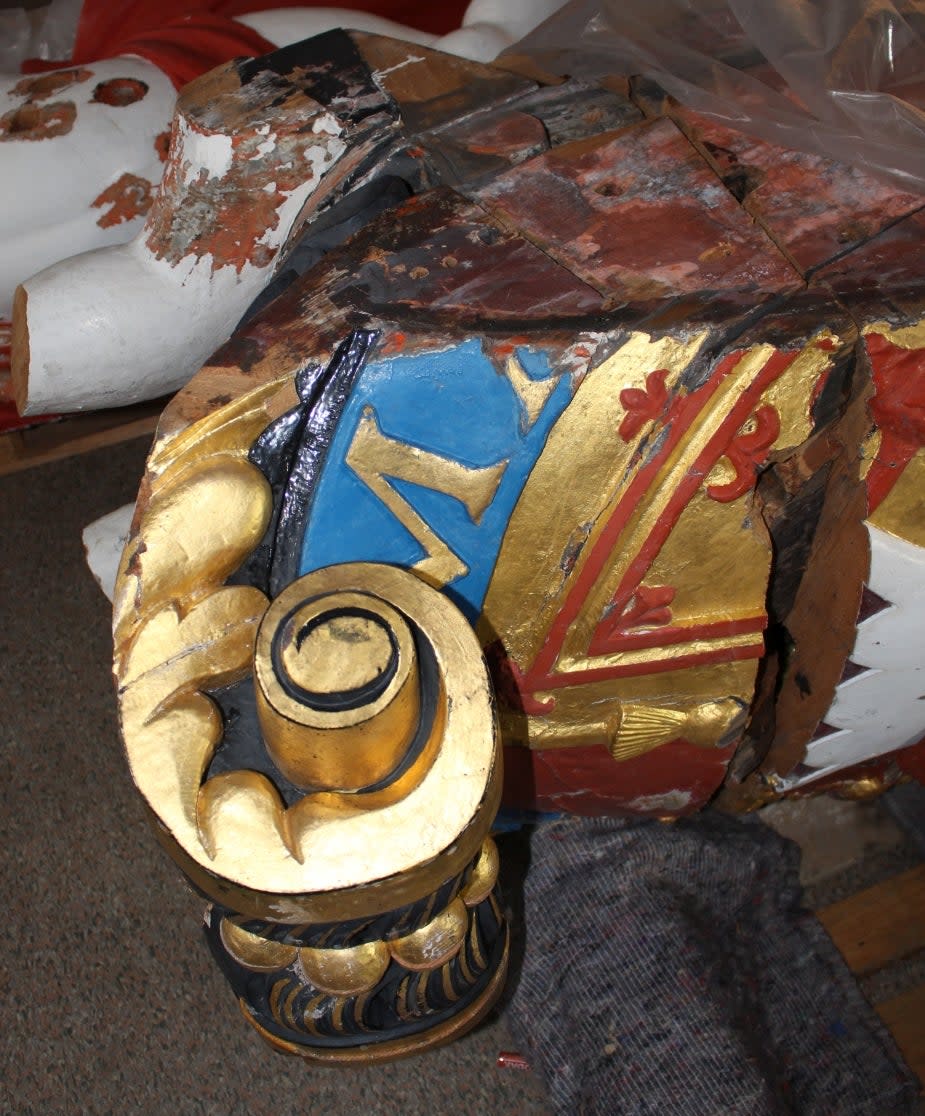Revealed: How a 200-year-old Royal Navy figurehead was mistakenly sawn into pieces

Left: Part of HMS Victory's 10 foot early 19th-century figurehead which, in 2009, was mistakenly thought to be a modern replica. Right: HMS Victory in 2007 – showing the sculpture just two years before it was sawn into pieces
(cc 3.0/National Museum of the Royal Navy)One of the most important art works in British naval history has been rediscovered by scientists.
The spectacular ten foot tall early 19th-century wooden figurehead is from the historic Royal Navy warship HMS Victory, the vessel which had been commanded by Admiral Nelson at the Battle of Trafalgar, and was thought to have been destroyed or lost in the mid-to-late 20th century – but scientific and historical investigations have now led to its 'rediscovery'.
Investigations over the past year have revealed that the figurehead - an exact copy (made in 1815) of the one borne by Victory at Trafalgar – has in fact survived.
In 2009 contractors working on behalf of the Royal Navy incorrectly thought that the giant 1815 sculpture had been destroyed in the second half of 20th century – and that the figurehead, adorning the ship's prow in the early 21 century, was therefore a modern replica. Because it was showing signs of decay, they therefore decided to remove it.
What was believed to be a 'modern replica' sculpture was consequently cut into six pieces with a chainsaw and put into storage and in 2012, responsibility for HMS Victory (and all related material in storage) passed from the Ministry of Defence to the National Museum of the Royal Navy.

Then in 2019, the museum decided to investigate the sawn-up sculpture and discovered that it was not a 'modern replica', but was in fact the 206-year-old 1815 replacement for the figurehead, damaged at the time Nelson had been killed on board that warship at Trafalgar a decade earlier.
The figurehead – in six fragments, courtesy of the 2009 chainsaw incident – will soon be installed in a new dedicated HMS Victory gallery at the museum - and will go on show to the public when the museum reopens after lock-down.
The discovery that it was not a 'modern replica' was made through very detailed research — scientists from the University of Lincoln carried out tests on surviving bits of paint on the figurehead's surface – and discovered that they dated not from the mid-late 20th century, but from the first half of the 19th century.
Museum historians then searched Royal Navy archives and discovered that the only post-Trafalgar record for the commissioning of a new figurehead for HMS Victory was a Board of Admiralty decision, taken in summer 1815. A letter written on June 20 of that year, states that the new sculpture was to be made on the Isle of Wight, at a cost of £65 (today the equivalent of £65,000).
The 1815 figurehead – an exact copy of the previous Nelson/Trafalgar-associated one – consisted of two angels supporting the UK royal coat of arms, surmounted by a crown.
It's not yet been decided whether the figurehead will be repaired, reassembled and potentially returned to its original position on Victory. Any decision will be determined by conservation, technical and historical presentation considerations.

"When we discovered that it was 206 years old, we were absolutely delighted," said Andrew Baines, the museum's deputy director.
But now, having established that the newly-dated sculpture was mounted on Victory's prow in 1816 (the year after it was made), the museum is turning its attention to trying to ascertain whether any fragments of its identical predecessor (the one associated with Trafalgar and Nelson) may have survived.
It was certainly removed in a refurbishment in 1814/1815 - and much of it was likely burnt. However, given the fame of Nelson's victory at Trafalgar, it is theoretically conceivable that some of the workers (or their foremen), refurbishing and repairing Victory in 1814/1815, may have kept some of the smaller key elements of the 10 foot tall sculpture – potentially the faces of the angels or the Royal Crest or Crown as souvenirs. If so, they could potentially still be in existence – in private hands somewhere in Britain.
The museum is keen to try to locate any potential fragments from that historic Trafalgar-associated figurehead and would like to hear from anybody who thinks they might have some.
"But we will also be doing additional scientific research to try to ascertain whether the newly-dated 1815 figurehead physically incorporated any elements of its Trafalgar-associated predecessor, or indeed how much of it has been repaired or replaced since 1816" said Mr Baines.

HMS Victory is by far the oldest surviving intact Royal Navy vessel – and is also the oldest really large intact ship in the world.
She was built in Chatham dockyard between 1759 and 1765 – and first went on active duty in 1778. After three major battles (1778 and 1780 against France; and 1797 against Spain), she was in a poor state of repair and was declared unfit for service – and turned into a hospital ship for wounded French and Spanish prisoners-of-war.
Between 1800 and 1803, Victory was repaired and refurbished (at a cost, in modern equivalent terms, of £530 million) - and given a new figurehead.
The vessel, then became Nelson's flagship – and it was on board her that Nelson was killed off the Spanish Atlantic coast at the Battle of Trafalgar in 1805.
Battle damage and wear and tear took their toll of the ship – and, in 1810, she was used as a troop carrier. Then, in 1814/1815, she was again repaired and refurbished (and then given the replacement figurehead - a copy of its Trafalgar-associated predecessor).
From 1816 onwards, because of her role at Trafalgar, she effectively became a museum ship and tourist attraction. In 1833, Princess Victoria visited her (and, as Queen, did so again in 1844). By the mid-1830s, 10,000 members of the public were visiting Victory every year – and this more than doubled by the mid-1840s.
In 1889, she returned to a partly military role – as the Royal Navy's School of Telegraphy.
But in 1903 HMS Victory was accidentally rammed by another Royal Navy vessel - and almost sank. What's more, many of her timbers were decaying fast. Restoration work between 1922 and 1927 saved her from disintegration.

After Napoleonic battle damage, severe leaks, rotting timbers, and serious damage caused by the ramming incident, the Luftwaffe succeeded in damaging her in 1941 with a 500 pound bomb.
By the 1950s, death watch beetle infestation was threatening her – and finally in 2009, naval contractors removed and chain-sawed her great figurehead bearing the royal insignia, incorrectly assuming that it was just a modern replica!
But, against all the odds, she has survived.
Today, she is the oldest commissioned warship in the world – and, in normal times, is visited by some 350,000 tourists from dozens of different countries every year.
Miraculously, large parts of the original 18th-century and early 19th century warship survive as integral parts of the vessel today.
Between 3% and 5% of the ship consists of original mid-18th-century timbers. A further 20% is from her 1800-1803 refurbishment - and 25% (including the newly identified and dated figurehead) is from her 1814-1816 refit.
For thousands of years, figureheads or their equivalents were important elements of any ship. They symbolised and embodied the power, status, function, identity and ethos of the vessel - and of the state or company that owned it. In battle, it was those figureheads which symbolically faced the enemy, as two opposing fleets sailed towards each other. Historically, they are therefore one of the most important elements of any historic vessel.


